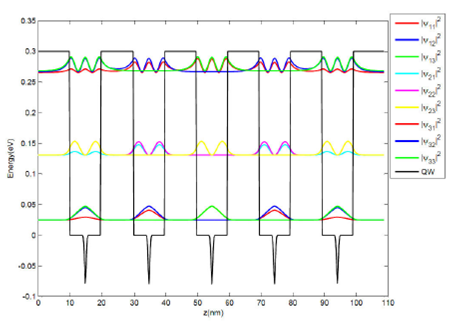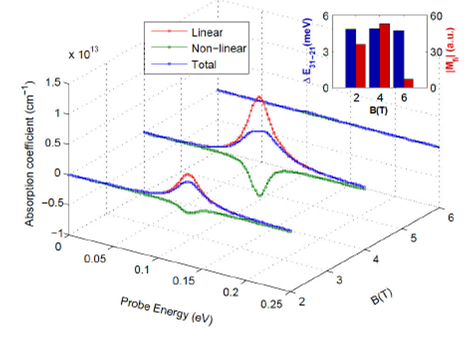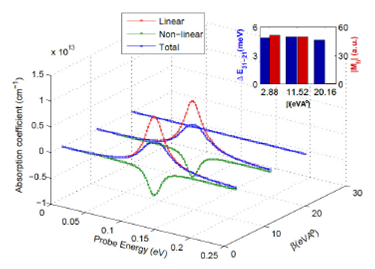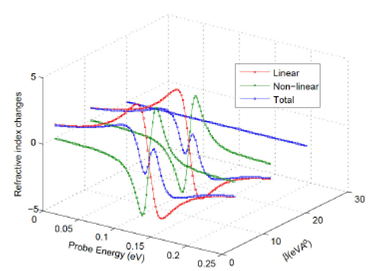1.Introduction
The study of the optical properties of low-dimensional semiconductor heterostructures with impurity doping attracts much interest given the vast possibility of purposeful manipulation by means of external influences. Elevation in growth methodologies have made it possible to introduce dopants which can be confined in a single atomic layer. Delta (or δ-) doping was given the name to the procedure of embedding highly localized impurity sheets within a semiconducting layer. Such a kind of growing impurity gives rise to a high-density quasi-two-dimensional electron or hole gas in low-dimensional semiconductor heterostructures. Using this doping technique, we can adjust the width and the profile of confinement potential of the heterostructure. The first report of such a dopant deposition is due to Bass 1, who found that a strong surface adsorption of Si to GaAs surface results in sharp doping spikes. The versatility of dopant deposition was realized by Wood et al 2, who mentioned that complex doping profiles can be achieved by “atomic plane” doping. Such tapering doping profiles can be mathematically described by Dirac’s delta function. The atomic plane doping profile was first implemented in a high electron mobility field effect transistor proposed as δ-FETs by Schubert et al 3,4. Many modernistic structures based on δ-doped structures can be experimentally realized and studied using various assembling techniques 5-8. In recent years, the physics communities have devoted a great deal of attention to carry out experimental studies of δ-doped quantum well structures. Lee et al 9 carried out experiments to study the transport and optical properties in the conduction band of δ-doped quantum wells. Tribuzy et al 10 studied the quantum confined Stark effect in GaAs/AlGaAs MQW structures containing a nipi δ-doping superlattice. Photoluminescence studies were carried out in the δ-doping and on the parabolic quantum well by Tobata 11 et al Luo et al 12, studied transport measurements on a δ-doped quantum well system with extra modulation doping and proposed that their results may be useful for simplifying circuitry design for low-temperature amplifiers, and devices for space technology and satellite communications. Very recently, excitonic light emission decay time measurements in moderately δ-doped GaAs MQWs using a time-correlated single photon counting system was investigated by Kundrotas et al 13.
Not only experimental but also theoretical studies of low-dimensional semiconductor heterostructures with δ-doping have gained great importance due to their potential applications in optoelectronic and photonic devices 14,15. Localization of impurities in δ-doped structures is used in devices to give a surge to quantum confinement of carriers. Furthermore, such δ-doped quantum well structures have many advantages, such as marked radiative recombination rates and notable values of the oscillator strength 16 that accounts for the large dipole moment expectation values. Ozturk et al 17 studied the linear and non-linear intersubband optical absorption in n-type δ doped GaAs semiconductor quantum wells. The effect of the δ doping location on the linewidth of the intersubband absorption in GaN/AlGaN quantum wells was reported by Edmunds et al 18. Tulupenko et al 19 have calculated the intersubband absorption coefficients for either center, or edge δ-doped quantum wells. The multisubband electron mobility in a barrier δ-doped GaAs double quantum well structure using the self-consistent solution of the coupled Schrödinger equation and Poisson’s equation was studied by Das et al 20. Almansour et al 21 have investigated the effects of the concentration and the thickness of Si δ-doped layer on optical absorption and refractive index changes in an InAlN/GaN single quantum well taking into account the piezoelectric polarizations.
The understanding of the electronic and optical properties of doping in the quantum wells heterostructures is imperative because the optical, electrical, and transport properties of devices made from these materials show exotic behavior in the presence of external fields 22-25. Among various electronic and optical properties in semiconductor quantum wells, the optical absorption and refractive index changes have drawn great interest in theory and experiment 26,27 In this study, we have investigated the intersubband optical absorption coefficients and refractive index changes in a GaAs/AlxGa1-xAs MQWs which includes an attractive δ-doping potential in the middle of each quantum well. The time-independent Schrödinger equation for this composite potential is solved numerically using the finite-difference technique to yield the allowed values of energy eigenvalues and eigenstates. The linear and non-linear optical properties are then investigated within the compact-density matrix formalism. The paper is organized as follows: In Sec. 2, we describe the model and theoretical framework. The Hamiltonian and the relevant eigenenergies and eigenfunctions, obtained using the effective mass approximation are presented analytically. The analytical expressions for the linear and non-linear optical absorption coefficients and refractive index changes, obtained using the density matrix approach are also presented in Sec. 2. The numerical results and detailed discussions are given in Sec. 3. Finally, a brief conclusion is made in Sec. 4 followed by references. Our results obtained with this model show that the position and the magnitude of the linear, non-linear and total optical absorption coefficients and refractive index changes are sensitive to not only the optical wave but the strength of the static magnetic field and location and strength of δ-potential also affect the positions and intensity of resonance.
2.Outlook on the theoretical model
2.1.Energy eigenvalues and eigenfunctions
The heterostructure system under study consists of symmetric GaAs/AlxGax1-xAs coupled quantum wells exhibiting the properties of a collection of single quantum wells in the presence of a static magnetic field. The potential profile of such a heterostructure can be described as:
where,
where n is the number of quantum wells, with period l. We assume, for simplicity, that in the coupled quantum well structure under consideration the neighbouring potential wells are so far apart that the wave functions of the individual potential wells do not overlap. The size of each well is L and the thickness of the barriers is fixed equal to the thickness of the wells. Apart from this, each well is having on-center δ-doping. A one-dimensional doping profile in a semiconductor can be treated to be like a δ-function, if the thickness of the doped layer is smaller as compared to other admissible length scales, which causes a conduction band bending. Such profile is described by the equation
In order to study the optical properties related to intersubband energy transitions in such a system, we consider the time-independent Schrödinger equation within the framework of effective mass approximation,
where
2.2 Linear and non-linear intersubband optical absorption coefficients and refractive index changes
In this section, we present a brief derivation of the linear and the non-linear optical absorption coefficients and refractive index changes. Consider that our quantum system is excited by an electromagnetic field. If the wavelength of the progressive electromagnetic wave is larger than dimension of a MQW, the amplitude of electromagnetic wave may be considered as a constant throughout, so that dipole approximation becomes valid. Then the electric field of an incident wave can be expressed as
When an electromagnetic radiation propagates through the material it produces changes in the spatial and temporal distribution of electrical charges in material and mainly the valence electrons are perturbed from their normal orbit. This perturbation is responsible for the induced polarization. In case of a weak radiation field, the induced polarization in the material is directly proportional to the applied field, but in the presence of an intense field, the induced polarization becomes a non-linear function of the applied field. The induced electronic polarization caused by the incident field is
The tilde (
Considering the medium and the applied field as a united system, the time variation of density matrix in the presence of damping is governed by the equation
where
with
The electronic polarization P(t) and susceptibility x(t) are defined by the dipole operator M and the density matrix ρ as
where V and ρ are the volume and the one-electron density matrix of the system, respectively.
Using this, the analytical expressions for the absorption coefficients and the refractive index changes based on linear susceptibility,
where
The susceptibility
where μ is the permeability of the material,
Using this approach, the linear and the third-order non-linear optical absorption coefficients are obtained analytically as follows:
Here I is the incident optical intensity.
The total absorption coefficient
The linear and the third-order non-linear refractive index changes are obtained using above analysis as follows:
Therefore, the total refractive index change
In the next section, we present the obtained results and the implications related to them.
3.Numerical Results and Discussion
In the system developed in this study, the linear and non-linear optical properties such as linear and non-linear absorption coefficients and the refractive-index changes as a function of photon energy are analyzed given by Eq. (13-18) for the GaAs/AlxGa1-xAs MQW with δ-doping. We have used the following physical parameters for the numerical computation,
The electron density is considered a unity. The parameters are suitable for GaAs/AlxGa1-xAs MQW. In our calculations, we have taken a position dependent electron effective mass,
We consider a combined system of isolated δ doped five wells system with the barrier height of each well kept constant at 0.3 eV. Eq. (2) for this system is solved numerically by using the finite-difference technique to provide the allowed values of energy eigenvalues and eigenstates. The solution gives the energy spectrum and the corresponding squared wave functions as a function of the position of z as shown in Fig. 1. Results show that energy levels coincide with their single-well positions and are five-fold degenerate in absence of magnetic field, as can be observed from Fig. 2. At B=0 T , we have three minibands each consisting of five energy levels within the confining potential. The difference between energy levels in a miniband is close to zero in the absence of magnetic field. Further it is observed that δ doping gives rise to better quantum confinement of electrons which leads to lowering of energy levels in δ-doped MQW structure as compared to undoped structure. We represent the energies of the levels by E nm where m and n correspond to the quantum numbers representing m th level in the n th miniband. Eg: the eigenvalue labelled E 11 corresponds to the energy of first level in the first miniband; E 21 corresponds to the energy of first level in the second miniband, etc. The presence of a magnetic field breaks the degeneracy and the energy levels get apart from each other leading to a nonequidistant energy separation between them as can be seen from Fig. 2.

FIGURE 1 Schematic representation of formation of minibands, first three energy levels in each miniband and orresponding squared wavefunctions as a function of position in a five period on-center delta doped MQW structure when B = 0.
In this paper we perform the calculations for transitions from state n=2, m=1 to

FIGURE 3 Plot of optical absorption coefficients as a function of the incident photon energy for different values of B.
The variation of these two factors is shown by bar graphs in the inset of Fig. 3 and can be explained as follows: With the increase in magnetic field strength the separation between the energy levels increases, though the increase is not very much pronounced. This occurs due to the fact that as the magnetic field is increased, the energy of each individual level increases and energy levels move away from each other, however, due to avoided crossing (see magnified image in Fig. 2) the increase in energy level spacing is not very much significant. The increase in the magnetic field causes a small blue-shift of the resonant peaks towards higher energy values. Further, the change in amplitudes of resonant peaks can be accounted to change in the value of dipole matrix element. The linear term
Now let us have a look at the results for the variation of the linear absorption coefficient

FIGURE 4 Optical absorption coefficients as a function of the incident photon energy for different values of the strength of ± potential.
Figure 5 corresponds to the plot of the variation of absorption coefficients as a function of the incident photon energy,

FIGURE 5 Optical absorption coefficients as a function of the incident photon energy for different values of doping positions in each well.
The refractive index changes are another important optical parameters in optical studies of quantum nanostructures. The outcome of analogous calculations for the influence of various parameters on the linear, third order non-linear and total refractive index changes as a function of incident photon energy is presented in Fig. 6 and 7. As seen from figures, the linear refractive index increases steadily with photon energy and reaches a maximum value. In that case, the structure gives normal dispersion for any frequency of incident photon where

FIGURE 6 Plot of refractive index changes as a function of the incident photon energy for different values of strength of 𝛿 potential.
4.Conclusion
In this paper, we have presented a complete study of linear and non-linear intersubband optical properties in a MQW with δ-doping under intense high-frequency laser field. The analytic expression of the optical absorption coefficients and refractive index changes was derived in detail by using the compact-density-matrix approach and the iterative method. The results of numerical calculations show that the optical absorption coefficients and refractive index changes are strongly affected by the magnetic field; the position and strength of the δ-doping potential, and the incident optical intensity. It is noted that the strength and the doping position are important factors in studying absorption spectra and hence should be taken into consideration when we do both theoretical calculation and experimental work. Moreover, in such structures, a favorable Stark shift characteristic occurs, which can be used to control and modulate the intensity output of the device. To our knowledge, there are very few reports of the absorption spectra in δ-doped quantum wells. With respect to the lack of such studies, we believe that our study makes an important contribution to the literature. The theoretical investigation of the linear and non-linear optical properties in such a system will lead to a better understanding of the properties of quantum wells. Such theoretical studies may have profound consequences about the practical application of the electro-optical devices, and the optical absorption studies also have extensive application in the optical communication.











 nueva página del texto (beta)
nueva página del texto (beta)




